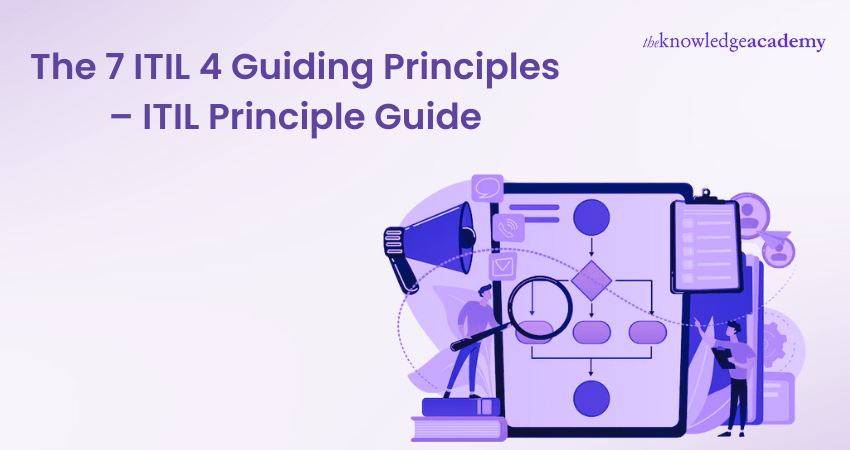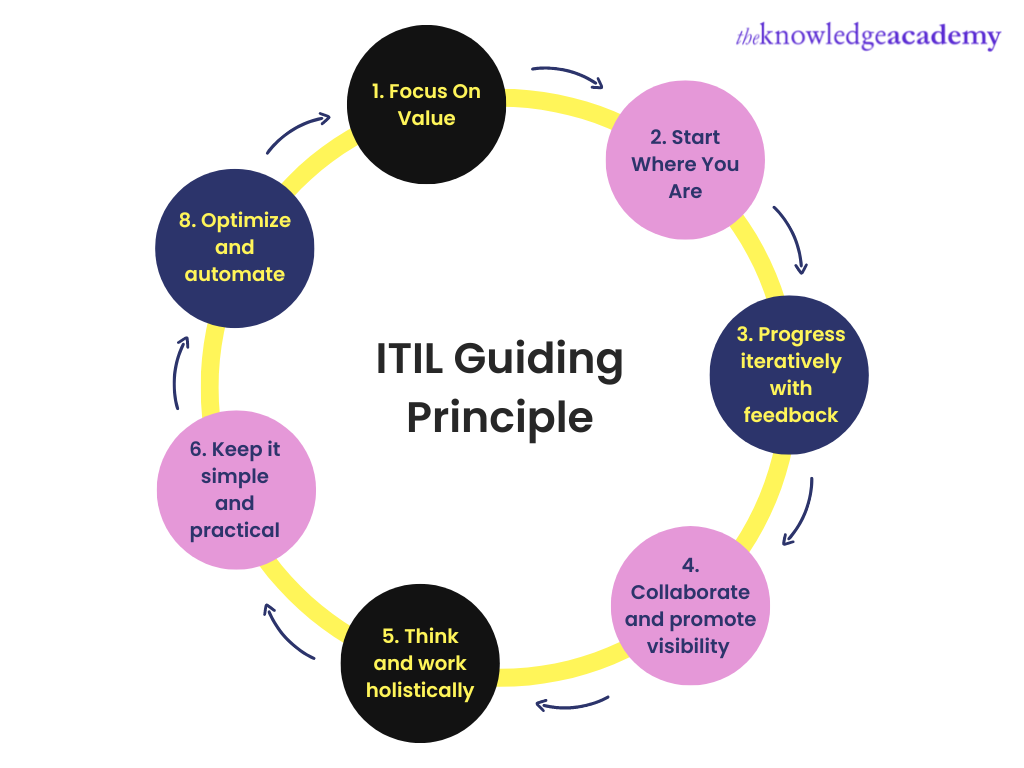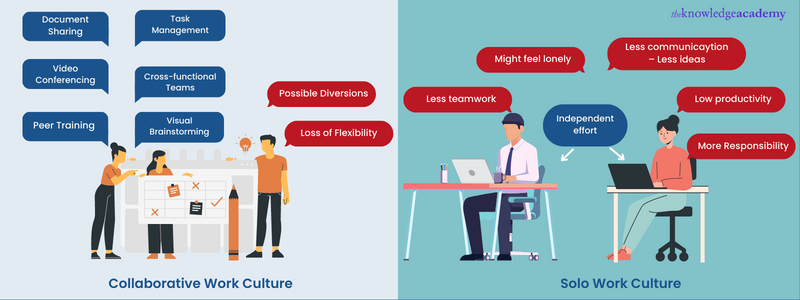We may not have the course you’re looking for. If you enquire or give us a call on 01344203999 and speak to our training experts, we may still be able to help with your training requirements.
Training Outcomes Within Your Budget!
We ensure quality, budget-alignment, and timely delivery by our expert instructors.

The 7 ITIL 4 Guiding Principles propose and offer guidance for practising ITIL Service Management essentials to support business needs.These Guiding Principles outlined lead in housing IT Service Management practices, emphasising critical aspects such as ITIL Capacity Management, to support and ensure successful IT services of the organisation. These Seven Guiding Principles, integral components along the ITIL certification path, is one of the modules common under the ITIL Managing Professional and ITIL Strategic Leader streams.
According to PayScale, the average salary of an ITIL Foundation level professional is £43,000, and the ITIL Expert level is £56,000 a year.
This blog, will help you understand the 7 Guiding Principles of ITIL 4, and more.
Table of Contents
1) The 7 ITIL 4 Guiding Principles
2) Seven ITIL 4 Guiding Principle Benefits
3) Usage of the 7 Guiding Principles of ITIL 4
4) Conclusion
The 7 ITIL 4 Guiding Principles
The 7 Guiding Principles of ITIL 4, integral to ITIL Project Management, are for people responsible for operating and managing organization's services throughout the ITIL Service Lifecycle, offering a pathway to consider "what next after ITIL 4 Foundation" for further development
1) Focus on value
2) Start where you are
3) Progress iteratively with feedback
4) Collaborate and promote visibility
5) Think and work holistically
6) Keep it simple and practical
7) Optimise and automate

Let us have a closer look at the ITIL Guiding Principles in detail.
1) Focus on Value
When we talk about value, it is not only in the context of finance, but also it motivates you to ponder about UX (User Experience) and CX (Customer Experience). You can expect better results only when you have conducted proper research on who is using your services and how these services create value for them.
Anything and everything the organisation would implement should create values for self, customers, and stakeholders. Apart from these personals you must also consider the employees, regulators, shareholders, society etc. ITIL 4 DPI contributes to the focus on value by providing a framework for strategic direction and continual improvement It is crucial to understand the customer's experience and perspective relevant to service and organisation to deliver the expected value.
For example, banking services include various banking products which have service channels like over-the-counter, mobile banking, ATM, and net banking. All the banking applications are hosted on an underlying IT infrastructure.
Failure in any part of the IT Infrastructure could impact the banking services and bring devious results to the bank's performance. For instance, a server-hosting failure in the mobile application can result in the mobile banking application being unavailable to the customers.
Hence, an IT service provider needs to focus on the value principle.
2) Start Where You Are
It is not required to start something from the start. Instead, you can consider improving on what you have been currently working on. In the pretext of a complete replacement, you do not have to build something new if you can avoid dumping the current project, as it can save you ample time and effort.
It saves time and effort and aids in maintaining people on board while helping you preserve its value. The previous endeavours will support the changes experimented with their contributions that have been appropriately valued.
While you indulge in assessment - it is improper to depend only on metrics and reports to analyse the present situation. Instead, you can gain better benefits when you observe the current situation and come to a conclusion.
For Example - In a service support team, if you regularly check on the performance of Call closure, it might result in improving only one direction (that is, Call closure) rather than resolving the purpose of the call or ITIL Incident Management.
3) Progress Iteratively with Feedback
You must hold out against the temptation of doing all the things at once. This can be possible if you can organise the work structurally into manageable chunks of undertakings that needs to be completed and executed promptly. With an overall focus and keen assistance, it is easier to maintain and manage projects that can bring enormous investments and deliver the anticipated value. Once the outcome or results are received, the feedback can be reviewed and examined to identify the issues, risks, and opportunities.
To understand this principle better, let us take an example of an organisation which has decided to build an application for the department of Operations.
The requirement stated by the department to include in the application - Create modules to communicate, report, and perform other functions to evaluate the operational performance, threat, quality, speed, and cost.
a) Once the IT service management understands the modules required for the operation-based application and has visualised the overall picture of the application, they will start working on it.
b) However, it is strenuous to create the complete application or product in one go. The developer might forget many points, and there might be many errors in the result, which need corrections to create a completely error-free product.
Further, the product created with continuous feedback and suggestions can achieve steady development. The whole objective of this principle is to obtain defect-free results without compromising the itil 4 service value system.
Gain in-depth experience and become a Process Owner with our ITIL Certification. Join now!
4) Collaborate and Promote Visibility

Collaboration does not just happen with your team members and service providers. It involves your users, customers, vendors, and anyone related to the services and a perspective crucial for individuals navigating ITIL careers.
You are supposed to be transparent about what is happening in the current scenario for a collaboration to be successful and effective. If the complete team is updated concurrently on the relevant information; and has a brief idea about what is happening, it saves a lot of time and effort for everyone to collaborate seamlessly.
Many people who work in isolation and are involved in individual tasks may perform outstandingly. But, the same people might find it strenuous to adapt to a collaborative work environment, as they are expected to be flexible and adapt to the latest changes. With the incorporation of ITIL 4 key concepts, after understanding the concept, they can perform better over time with everyday practice and a few rehearsals.
Eventually, people working in collaboration with an agenda can bring significant impact and value to the customers, partners, and everyone associated with the organisation.
5) Think and Work Holistically
Have you ever noticed that working faster at times can affect/strain your results or other domains of your organisation?
It is crucial to consider this point when working in a collaborative environment to confirm that your work does not affect any part of the organisation and create any form of hindrance or disruption. As every department is interconnected with the organisation, you can contemplate a broad range of planning and make decisions regarding the impact generated by the decision made is beneficial for the whole organisation.
For instance, let us take an example of an organisation launching and promoting a new product.
The product launch will be successful only if you have previously worked with caution to ensure that your product caters to the demand of your customers. This achievement can be possible only if you have done enough product research, considered customer feedback, and brainstormed with your team members to improve the product.
Once the product has passed through the trial phase, you can start promoting it effectively (like email campaigns, road shows, social media marketing and more) to communicate to the right audience. It is also crucial to launching your product at the right time.
Learn about various guiding principles of ITIL in Digital and IT strategy with our ITIL 4 Leader: Digital and IT Strategy DITS course now!
6) Keep it Simple and Practical
Rather than following the traditional conventions, it is better to follow the simple things which can create Value. Unless you feel the complex steps are necessary for a solid reason, stop doing them. Avoid doing anything which is creating hindrance to the Value. Think practically and try to use minimal steps which are only necessary to complete the process.
Your process is expected to cover the basics and perform better in each situation. You can train your team based on the requirements and difficulty of the circumstance.
For example, let us take a scenario when you have tried Signing up for an application. Once you have entered the page, you will look at its UI to judge its capability to some extent. Finally, when you start the signing up process, you will expect it to have minimal steps and finish it as soon as possible.
The buffering time, the time taken to display the login details after the form submission and many other such minute details are all observed.
So, that's how this principle works, ensuring the simplification of the process and keeping value in mind. Keeping it simple does not mean compromising the quality of the product.
On a lighter note, you might also be wondering how to grasp the knowledge and details of the entire blog as quickly as possible!
Finally, let us now jump to our last guiding principle.
7) Optimise and Automate
As we know, optimising means making something functional and applicable. Before automating an activity, it should be optimised to a certain degree to utilise the resources to the best of their limits.
It is better to start the process manually to optimise the workflow. You can automate the process once you feel it is efficient to use all the tools and resources effectively. Understanding the differentiation between which of the process needs to be manually designed and which can be automated is highly significant when taking a decision to avoid any resource wastage.
First, consider the overall scenario and decide if the process requires automation. For example, if you are an HR professional, you might build an automation process to fill in dates and months to enter the daily attendance details of the employees. And for the same process, if HR wants to add onboarding details, it does not make sense, as it does not happen daily.
An example of optimising the work culture is replacing paper with cloud-based tools and reviewing existing processes to understand where improvements can be made.
Seven ITIL 4 Guiding Principle Benefits
To create and construct the best measures and applications for your team, you may not keep track of time and end up spending a massive amount of time unintentionally (or redundantly). Thus comes the ITIL 4 Guiding Principles as lifesavers forming uniform guidance and procedures.
The benefits of ITIL 4 Guidelines are extended beyond the IT department that include:
1) Cost Minimisation
2) Practical and effective utilisation of resources
3) Better alignment between the organisation and the IT department
4) Intelligible expectations briefed up for customers and IT service desk
5) Assets Visualisation, a key component within the broader scope of ITIL Asset Management.
6) Better control over risks, service disruptions, and system failures
Those who wish to be involved in learning the diagnosis problems, you can master the Root Cause Analysis Training now.
Usage of the 7 Guiding Principles of ITIL 4
A comprehensive examination of ITIL Advantages and Disadvantages is crucial to tailor their application effectively and achieve optimal outcomes, highlighting the importance of a holistic approach to service management.
Each Guiding Principle has its value; it increases when you articulately combine them to get the most out of it. For example: In an organisation, if you apply the principle “Optimise and Automate”, you should also integrate the “Think and Work Holistically” principle to ensure improvements and deliver the required results.
You can similarly combine all the other principles of ITIL 4. Applying them with relevance to the context can help you derive simple yet practical results.
Considering elements such as ITIL 4 demand management when comparing ITSM vs ITIL can further optimise your plan, enabling you to choose the best framework tailored to your organisational needs.
If you are making any improvements or planning a new process, you can get a printout of these Guiding Principles and stick it around the working area or desk to remind you of what is paramount.
Conclusion
In this blog, we have discussed ITIL 4 and its seven Guiding Principles. Organisations should understand the relevance of each guiding principle and not apply only one or two of them. Instead, consider entangling them together based on the necessity of the given situation.
Are you an IT professional managing IT-enabled services and digital products? Then, this ITIL 4 Specialist: Create Deliver And Support CDS training course, is for you.
Frequently Asked Questions
Upcoming IT Service Management Resources Batches & Dates
Date
 ITIL® 4 Foundation Certification Course
ITIL® 4 Foundation Certification Course
Sat 4th May 2024
Tue 7th May 2024
Thu 9th May 2024
Mon 13th May 2024
Wed 15th May 2024
Sat 18th May 2024
Mon 20th May 2024
Wed 22nd May 2024
Tue 28th May 2024
Thu 30th May 2024
Mon 3rd Jun 2024
Wed 5th Jun 2024
Mon 10th Jun 2024
Wed 12th Jun 2024
Sat 15th Jun 2024
Mon 17th Jun 2024
Wed 19th Jun 2024
Mon 24th Jun 2024
Wed 26th Jun 2024
Sat 29th Jun 2024
Mon 1st Jul 2024
Wed 3rd Jul 2024
Mon 8th Jul 2024
Wed 10th Jul 2024
Sat 13th Jul 2024
Mon 15th Jul 2024
Wed 17th Jul 2024
Mon 22nd Jul 2024
Wed 24th Jul 2024
Sat 27th Jul 2024
Mon 29th Jul 2024
Wed 31st Jul 2024
Mon 5th Aug 2024
Wed 7th Aug 2024
Sat 10th Aug 2024
Mon 12th Aug 2024
Wed 14th Aug 2024
Mon 19th Aug 2024
Wed 21st Aug 2024
Sat 24th Aug 2024
Tue 27th Aug 2024
Thu 29th Aug 2024
Mon 2nd Sep 2024
Wed 4th Sep 2024
Sat 7th Sep 2024
Mon 9th Sep 2024
Wed 11th Sep 2024
Mon 16th Sep 2024
Wed 18th Sep 2024
Sat 21st Sep 2024
Mon 23rd Sep 2024
Wed 25th Sep 2024
Mon 30th Sep 2024
Wed 2nd Oct 2024
Sat 5th Oct 2024
Mon 7th Oct 2024
Wed 9th Oct 2024
Mon 14th Oct 2024
Wed 16th Oct 2024
Sat 19th Oct 2024
Mon 21st Oct 2024
Wed 23rd Oct 2024
Mon 28th Oct 2024
Wed 30th Oct 2024
Sat 2nd Nov 2024
Mon 4th Nov 2024
Wed 6th Nov 2024
Mon 11th Nov 2024
Wed 13th Nov 2024
Sat 16th Nov 2024
Mon 18th Nov 2024
Wed 20th Nov 2024
Mon 25th Nov 2024
Wed 27th Nov 2024
Sat 30th Nov 2024
Mon 2nd Dec 2024
Wed 4th Dec 2024
Mon 9th Dec 2024
Wed 11th Dec 2024
Sat 14th Dec 2024
Mon 16th Dec 2024
Wed 18th Dec 2024







 Top Rated Course
Top Rated Course



 If you wish to make any changes to your course, please
If you wish to make any changes to your course, please


